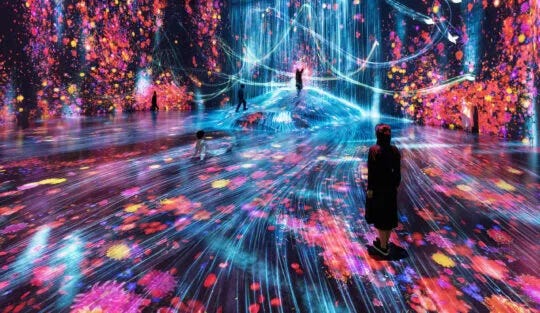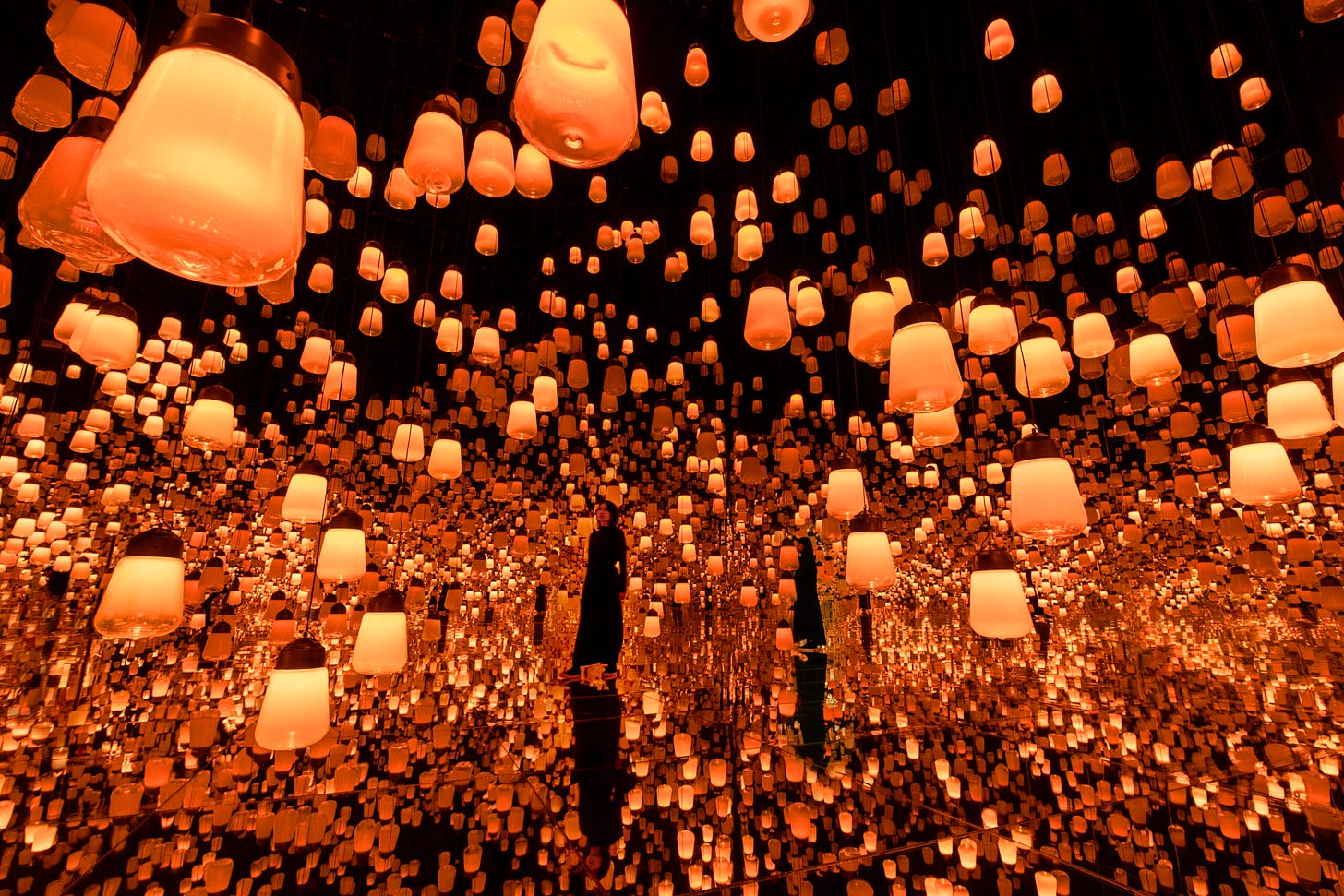“Digital art is the ultimate bridge builder”
Lars Hinrichs unveils his vision for the UBS Digital Art Museum in Hamburg, sharing how digital art became his passion.
I’m back from my summer holiday. We had a wonderful time on our trip to the Baltic Sea coast and eastern Germany. With the NEXT Conference in September approaching, my diary is filling up again.
At NEXT25, Lars Hinrichs will tell us more about a project that has been taking shape over the last couple of years: the UBS Digital Art Museum. It’s exciting that Hamburg is set to become another hotspot. However, we will have to wait roughly another year before it finally opens.

Serial entrepreneur Lars Hinrichs, best known as the founder of XING and a pioneer of Germany’s digital economy, is now venturing into the cultural space. In Hamburg’s HafenCity, he is developing the UBS Digital Art Museum – a large-scale institution dedicated to immersive, born-digital art with the encompassing exhibition “teamLab Borderless” by the international art collective teamLab at its core. At the NEXT Conference in September, he will offer the first behind-the-scenes look at the project. In this interview, Lars explains how a personal fascination evolved into a major cultural initiative, why digital art is more than just a spectacle, and what visitors can expect when the museum opens in 2026.
You’re best known for building digital ventures. But before this museum project, art wasn’t something publicly associated with you. How did your journey into that world begin?
It started with a moment that deeply moved me. When I was 16, I visited the MoMA in New York and saw a monumental steel sculpture by Richard Serra. It was an emotional experience – like falling in love. That moment stayed with me.
Years later, in 2016, I visited the Fondation Maeght in the south of France and saw Cold Life by the Tokyo-based collective teamLab. It had that same powerful impact. I was completely absorbed. That work became a turning point. We eventually acquired one of the limited editions of Cold Life – teamLab only sells certain pieces in editions of five, and only to institutions, never to private collectors.
The power of connection
So that encounter with Cold Life led directly to the museum?
Yes. I’ve always believed in the power of connection – it’s been a core theme in my work. Art, especially digital art, is a way to create connections between people, cultures, and perspectives. That’s what teamLab’s work does. Their art doesn’t just use digital tools – it’s born digital. It only exists because of technology.
I began following teamLab’s work internationally – in London, Stockholm, Tokyo – and was blown away by their full-scale museum “teamLab Borderless” in Tokyo. People were lining up, and everyone left with a smile. It was a universal experience. That’s when I knew: we need something like this in Hamburg.
How did you take the leap from inspiration to institution?
I was involved in a real estate project in HafenCity. We were looking for a use for the ground floor that would attract the public. Coming back from Tokyo, I proposed creating a digital art museum. My partners were sceptical at first. But I convinced them, secured the basement and parts of the ground floor, and began working on the concept.
In August 2019, I travelled to Tokyo with Hamburg’s mayor, Peter Tschentscher. He was impressed by teamLab’s work and deeply persuaded that it would enrich Hamburg’s cultural scene. We signed a letter of intent with the collective during that visit. That kind of support from the city really helped.
Overwhelming in the best sense
What kind of experience should visitors expect?
It will be overwhelming – in the best sense. Our aim is to move people, regardless of age. The exhibition will be multisensory: visual, auditory, tactile, even olfactory. In Tokyo, teamLab also works with taste, though we’re not there yet in Hamburg.
Visitors can interact with the artworks – touching and photographing is not only allowed, it’s encouraged. The soundscapes are original compositions by teamLab, subtly embedded within each artwork. The boundary between artwork and viewer dissolves. Once you touch an artwork, it reacts to your gestures and movement and eventually changes its shape.
Some works move from one room to another. Every experience is unique – the artworks evolve depending on season, time of day, and who is present. You can visit multiple times and never see the same thing.

When will the museum open?
In 2026. We hope for the second half, but we’re not committing to an exact date yet. What’s certain is that it will open that year. More than 10,000 tickets have already been sold. Early visitors are guaranteed early access, and we expect strong demand.
How many people can the museum accommodate?
Fire safety regulations limit us to 800 visitors in the exhibition at one time. With 6,500 square meters of space, that means a relaxed experience. Using timed entry slots, we expect several thousand visitors per day, and we’re targeting over 700,000 annually.
Not just an exhibition space
UBS is the title sponsor. What role do they and other partners play?
UBS is our lead partner – that’s why it’s officially the UBS Digital Art Museum. It’s a private museum, so strong partnerships are essential. UBS has a long-standing reputation in the art world, sponsoring Art Basel and maintaining a respected corporate collection. Their support adds credibility, especially when people ask, “Is this really art?”
We also have support from Hapag-Lloyd and Signal Iduna. Additional partnerships are in the works, among them with one of the most valuable and established telco brands worldwide. We offer various models of cooperation, including event access, brand visibility, and co-hosting opportunities, all tied to financial support, of course. Long-term sustainability is key.
The building itself must be highly specialised.
Very much so. It’s not just an exhibition space – it’s purpose-built for this kind of immersive art. Some rooms are more than 12 meters high, and entirely column-free. We’re using Cobiax technology in the concrete slabs to reduce weight while maintaining structural integrity.
The museum will also include more than 17,000 electronic components. It’s one of the most technologically advanced cultural buildings ever developed in Germany.
Why did you choose Hamburg?
I’m from Hamburg. I wanted this to happen here, in my hometown. Hamburg has recovered economically faster than other German cities post-Covid. Politically, we’ve had stable, constructive leadership, and the city supports both digital transformation and culture.
The museum complements Hamburg’s existing institutions. It will make the city even more attractive as a cultural destination. And symbolically, I think it matters that we’re doing this here – a forward-looking project in a city that embraces innovation.
Any final thoughts?
Just that it all started a decade ago with a single piece of art – and now we’re building a whole museum. In the art world, that kind of pace is almost unheard of. I believe digital art is the ultimate bridge builder. It connects generations, cultures, and technologies in a way that feels deeply human. That’s what we’re trying to create.
More about art and creativity
First published at nextconf.eu.

